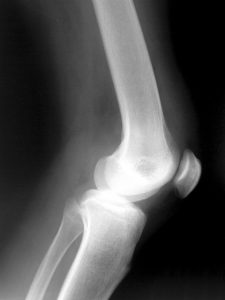Jumper’s Knee
Jumper’s knee, or patellar tendonitis, is a knee pain caused by tiny tears in the patellar tendon. This tendon connects the knee cap to the lower leg and is often strained by jumping activities, sports, or even going up-and-down stairs. Keep reading to learn about diagnosis and treatment for this common overuse injury.
Diagnosis of Jumper’s Knee
If you think you may be suffering from jumper’s knee, you should get a physical exam by a qualified medical professional. If you have a positive diagnosis, you will likely be experiencing pain to palpation of the tendon. You may also have swelling in that region and it may hurt when you extend your knee. Most importantly, the pain you experience with jumping is very localized and easy to reproduce.
Typically the first imaging study obtained is a simple x-ray to rule out any pathology involving the patella, such as arthritis. X-rays will also show calcification with the patellar tendon itself that could be the cause of pain.
An MRI scan is also used to help with the diagnosis. Many times a MRI scan will help determine the extent of the pathology. Some cases of jumper’s knee are an inflammation of the patellar tendon. In more advanced cases, the tendon actually changes its composition and becomes tendonotic. In the worse case, there are small tears within the tendon. There were be pain over the patellar tendon in the area where the tendon is inflamed. Sometime there will be micro tears in the tendon. The tears can be identified via a MRI scan.
Treatment of Jumper’s knee
Treatment for jumper’s knee ranges from rest to surgery. The first step to recovery is to identify what activity causes the problem. The inciting activity needs to be stopped. Relative rest is important. Switching to another sporting activity during the recovery phase is key. The next step is to reduce the inflammation to the patellar tendon.
Reducing the inflammation can be completed by using a patellar tendon strap. The strap will decrease the force on the injured tendon. Ice is also important. There is no time limit on how often to ice or how long the ice should be applied–as much as tolerated is the recommendation.
Medication
An oral anti-inflammatory medication can also help reduce the inflammation. That being said, as with any medication, there are side effects. So medication use should be limited.
Injection Therapy
A cortisone injection should never be administrated in the patellar tendon, as it could cause the tendon to rupture. However, one injection option is the use of PRP. PRP is short for Platelet Rich Plasma, a form of regenerative therapy. PRP is obtained by drawing blood for the arm of the patient. The blood is then placed in an in-office centrifuge. The platelets and the plasma are separated from the rest of the blood cells. The platelets are full of anti-inflammatory factors and proteins. By injecting the PRP in the area of inflammation, it will heal the tendon.
Physical therapy can also help. Your physical therapist can use different treatment modalities to reduce the inflammation. They will also identify if there are any strength deficients that need to be corrected, to help prevent the injury from occurring again.
In advanced cases where the micro-tears are present and conservative treatment has failed, surgery is likely necessary. The surgery is done to resect the area of the damaged tendon and repair the healthy portions back to together, side-by-side.
If you are struggling with symptoms of jumper’s knee, Orthopaedic Specialists can help! To schedule an appointment with Dr. Grossfeld and the other experts at Orthopaedic Specialists, call 502-212-2663 today.


Recent Comments